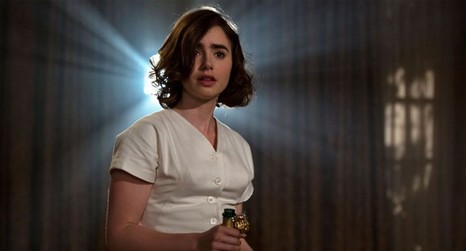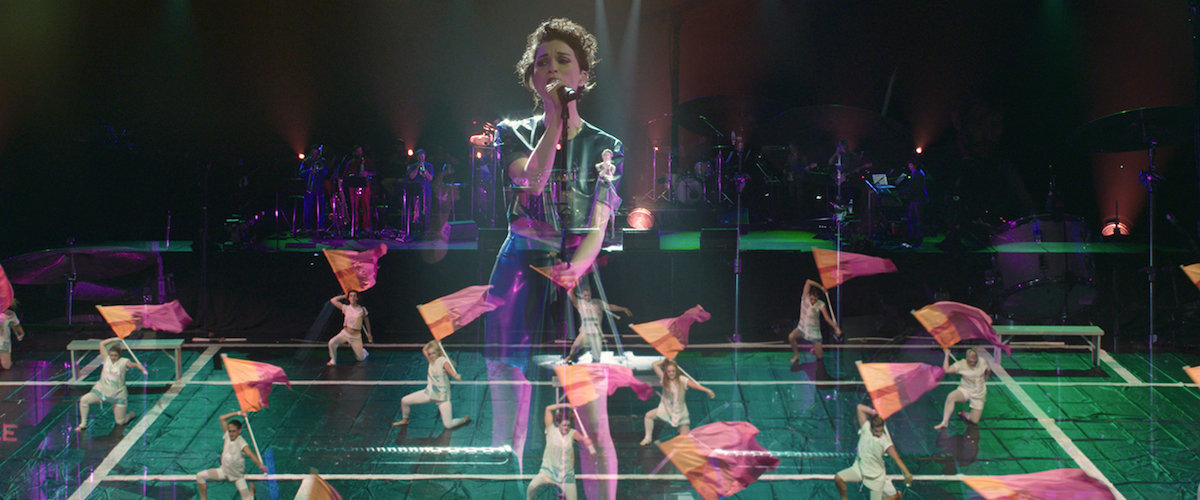|
What if Godzilla was a projection of your issues? That's the question posed by "Colossal," a new film by Nacho Vigalondo in which an alcoholic screwup named Gloria (Anne Hathaway) unleashes terror on Seoul, South Korea, in the form of a giant monster by getting blackout-drunk.
This sounds like the premise of a "Saturday Night Live" sketch blown up to feature length, but part of the weird charm of "Colossal" is its willingness to be that kind of movie to the Nth degree. It warmly embraces the central idea and explores it in detail, without burdening it with gravity that it can't support. Vigalondo, who has carved out a niche making wry, small-scaled, rather peculiar genre films, doesn't do that. This movie feels as if somebody woke from an intense nightmare, decoded it and realized it was rather unsubtly working through some of their unresolved problems, then brought it to Judd Apatow and said, "Here's your next comedy." Read more
0 Comments
In theory, "Rules Don't Apply" is about a couple of young people--Alden Ehrenreich, a driver for Hughes, and a would-be starlet played by Lily Collins, who moves out to Los Angeles with her mother, who's played by multiple Oscar nominee Annette Bening, Beatty's wife. Collins' character is one of 28 young women being groomed as starlets by Warren Beatty's Howard Hughes, theoretically for a movie that he hopes to direct. There are talent classes; lavish parties and shots of vintage architecture; cars and clothing; a budding romance between the two young leads; and a sharp right turn into an age-inappropriate relationship between the heroine and Hughes, who is defined throughout the film's first third mainly as a disembodied voice on the telephone, like the way "Seinfeld' treated George Steinbrenner on "Seinfeld" and the comic strip "Doonesbury" depicted presidents.
But as Scout Tafoya's latest edition of "The Unloved," and one of my favorites, points out, "Rules Don't Apply" is mainly about the mystery and audacity of its writer, director and co-star, Warren Beatty, a man who's nearly as curious a figure as Howard Hughes. It makes sense that Beatty would have made his long-delayed return to filmmaking and acting with "Rules Don't Apply," playing the reclusive aviation magnate turned film producer. Read More Loud, trashy, sweet and weird, the Mighty Morphin Power Rangers reboot “Power Rangers” is not merely an ideal film for rambunctious and undemanding 12-year olds, it actually sees the world through their eyes.
In theory, the heroes are high school students. But they’re actually a Disney Channel-styled fantasy of the splendors that await kids when they finally become full-fledged teenagers and can Do Whatever They Want. These heroes are misfits. They gather in detention in their high school, a scenario that promises to turn into “The Mighty Morphin Breakfast Club Rangers.” Lo and behold, that’s what you get: a mix of shenanigans, heart-to-heart talks and widescreen punch-outs between monster battles. Read More I'm in the tank for Terrence Malick. I don't believe that the Austin-based director has ever made a bad movie, just ones that were too fragmented, mysterious and intuitive to connect with a wide audience. I thought "Knight of Cups" was one of last year’s most daring features, but I realize this is a minority opinion. Mention the director to a movie buff these days and you’re likely to get jokes about voice-overs and perfume ads and twirling in fields, plus complaints that Malick is too much of this and not enough of that, and not what he used to be.
I don't care. I love that after 44 years of feature filmmaking, his style is still an issue. Even at its most obtuse, Malick’s work never plays by commercial cinema's rules, coming at characterization and story from odd angles when it isn’t chasing the ineffable, as his camera chased a butterfly in “The Tree of Life.” The actor and filmmaker Tim Blake Nelson, who had a small role in Malick's epic 1998 war poem "The Thin Red Line," said the difference between Malick and most other filmmakers is "the difference between [Georges] Seurat painting with dots and [Paul] Cezanne, who's a more painterly painter." Read more The American college fraternity experience has birthed a growing subgenre of films, with Richard Linklater's "Everybody Wants Some!" and Andrew Neel's "Goat" sparking recent discussion for the way they use Greek organizations' obsession with male bonding rituals and tradition as a way to criticize the world beyond college. The tale of an "Everyman" college student being drafted into a fraternity as a pledge and sticking with it through Hell Week and beyond is inherently dramatic, and not just because it comes with a handy built-in time frame, one semester or year of higher education. Almost every pledge story told on film seems to end up becoming the story of innocence lost or ignorance reinforced. The young man seeking fraternity initiation goes into the experience in search of abstract ideas like "brotherhood" and "oneness," and emerges on the other side cynical and disillusioned or radicalized and awake. The journey can be played at any emotional pitch, and because the main characters are young men living in the zone between adolescence and true adulthood, the filmmaker can play it all sorts of ways, from slapstick comedy ("Old School") to horror ("The Brotherhood")
"Burning Sands," Gerald McMurray's feature filmmaking debut, is one of the fresher entries, thanks mainly to its setting: a historically black fraternity on a historically black campus like Howard, the university where the co-writer and director got his degree. Spike Lee's second feature "School Daze" had a subplot set in a black frat and showcased a lot of hazing, but the scenes were played mainly for very grim laughs. "Sands" presents itself in trailers as a comedy along those lines, but it's no joke. McMurray's strongest virtue is his ability to thread that comedy-drama needle while he tells the story of Zurich (Trevor Jackson), aka Z, into Lambda Phi, a prestigious Greek organization once attended by the school's dean (Steve Harris), who proposes the young man for membership. Read More All monster films fall into one of two categories: the kind that takes its time revealing the monster, and the kind that shows you the monster right away and never leaves it for long. Think “Jaws” (fins and scary music for the first hour) as opposed to “Deep Blue Sea” or “Sharknado” (Shark-o-Rama pretty much throughout). Most versions of the King Kong story have fallen into the first category: the 1933 original, the 1976 remake, and Peter Jackson’s three-hour 2005 version unveiled the big ape gradually. “Kong: Skull Island,” on the other hand, introduces Kong after less than half an hour, then keeps him (and lots of other big, scary creatures) front and center throughout the film’s 118-minute running time. There’s even a moment where another character tells a story about Kong battling creatures and the movie cuts to images of Kong battling the creatures, in case you weren’t getting your fill of monster-on-monster action.
I’m not mentioning the difference in approach to condemn the new Kong: quite the contrary. This one—about a team of soldiers and scientists that gets stranded on Skull Island during a mission to map the island’s geological interior with explosive charges, which you absolutely should not do when visiting a place called Skull Island—is a half-magnificent, half-misguided example of a “show me the monster” movie. At its best it reminded me of “The Mysterious Island” and “The Land that Time Forgot,” films that were little more than collections of monster-driven action scenes hitched to a perfunctory story about explorers wandering a jungle, doing stuff they were warned not to do, and getting eaten. Read more "Table 19" is a movie for everyone who has ever felt deeply uncomfortable at another person's wedding reception. That might not sound like a ringing endorsement—in fact it would make one of the least appetizing DVD box quotes of all time—but there is such a thing as a under-served market, and this movie serves it. Maybe too well, as we'll see.
The title refers to the number of a table at a wedding reception. It's far away from the bride's and groom's family tables. In fact it's about as far back as you can get and not be out on the street. It takes a while for everyone at the table to figure out the common element that resulted in all of them being placed at this particular table. Suffice to say that they all have a problematic relationship with somebody in the wedding party, and that's how they ended up seated in a corner near a restroom. Read more I don't know exactly what I expected of "Contemporary Color," but I definitely didn't expect what I got. That makes it very much on brand for David Byrne, the former front man of the Talking Heads and primary creative motor behind this curious and fascinating movie. Byrne has always specialized in art that defies easy categorization, and that's what this movie is. You could call it a musical performance documentary and not be wrong, but it's trying to do other things, too—some expertly and others not so well. There's never a point where you quite get a handle on it because it keeps changing in front of your eyes.
In theory, this documentary from New Orleans-based filmmakers Bill and Turner Ross is a recording of a concert at Brooklyn's Barclay Center arena that paired off high school color guards with top pop acts, including Ad-Rock of the Beastie Boys, St. Vincent and tUnE-yArDs. This is not a formal collaboration between the musicians and the dancers in the color guard, a phalanx of high school students in leotards who swirl flags and toss rifles and strike poses in time to music. What's happening between the musicians up on the stage and the color guard on the floor seems like a form of interpretive art. The color guard is making a work of art that responds to the music. Read more You can honestly say of this film by writer/director Macon Blair that they don't make 'em like they used to. "I Don't Feel at Home in This World Anymore" is an American independent film from the 1990s that just happens to have been released this year.
The stakes are small compared to what tends to happen in American movies now; the story is rather slight; the filmmakers pay closer attention to the small details of character interaction than to the fine points of plot. The whole thing is mainly situational: we get to watch the heroine, Ruth Kimke (Melanie Lynskey) as she reacts to having her house broken into and follow along as she decides to locate and punish the people who did it with help from an oddball neighbor (Elijah Wood's Tony), who's enamored with morning stars and nunchucks. Read more I keep forgetting the title of “A Cure for Wellness” and calling it “The Color of Despair.” It’s an accurate mistake.
As directed by Gore Verbinski ("Pirates of the Caribbean: The Curse of the Black Pearl," "The Lone Ranger"), this film about a New York financial wiz (Dane DeHaan) getting trapped in a creepy Swiss clinic wants to be sickly-dreamy horror epic. It’s a black-and-white movie done in color. The stark photography by Bojan Bozelli creates pools of blackness and acres of negative space. Jenny Beavan’s retro-gothic costuming and Eve Stewart’s production design favor ash, bone, eggshell, curdled cream, and shades of green ranging from bile to moss. If you could nick a David Fincher film’s throat, hang it upside down, and bleed it for two days, it would look like this movie. As a fetish object, it’s impressive. Read more |
Matt Zoller SeitzFilm critic and filmmaker. Archives
April 2017
Categories
All
|











 RSS Feed
RSS Feed